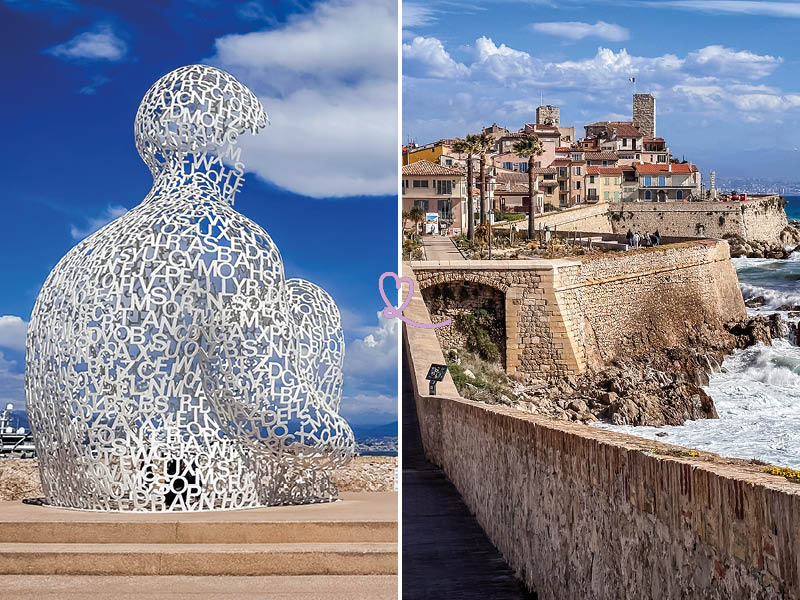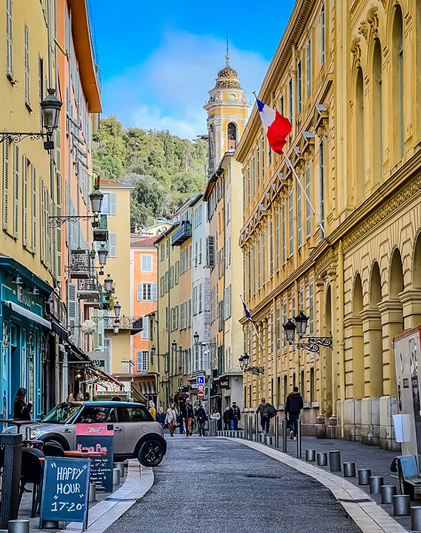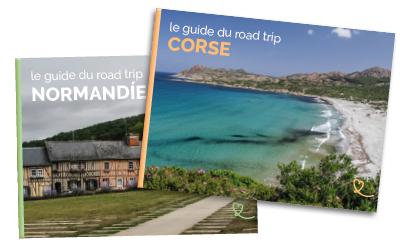Ready to discover Antibes’ must-sees? In this article, we present the ramparts of the old town, which give this Vauban citadel its undeniable charm. Antibes has always been a strategic city, thanks to its seaside location and proximity to the Italian coast. Its ramparts, redeveloped over the centuries, reflect its history! The same is true of the harbor, an ancient port that is now Europe’s leading yachting harbor. This is where you’ll find the monumental sculpture Le Nomade, by Jaume Plensa. Fun and photogenic, it’s a source of pride for the locals!
In this article, we’ll give you all our tips for visiting the ramparts and the Nomade du Port Vauban.

This guide is completely independent, based on our experiences. We visited the region anonymously, making our own choices and paying our bills in full.
Why visit the Nomade, Port Vauban and the ramparts?
Why are they worth it? Our opinion:
The ramparts and Port Vauban are a must-see during your stay in Antibes! They are truly part of the city’s identity. The Port Vauban separates the majestic Fort Carré from Old Antibes. On its main quay, Quai Henri Rambaud, you can see the Nomade. We went to the foot of this white steel sculpture and particularly liked it. From the quay, we then walked along the ramparts, from the old town to Plage du Ponteil. It was a very pleasant walk! See our other ideas for activities in Antibes in our dedicated article.

Why is the Nomade famous?
Le Nomade is a sculpture by artist Jaume Plensa, born in Barcelona in 1955. Installed for a temporary exhibition in 2007, it was so popular with local residents that it returned to take its place on Quai Henri Rambaud in 2010. It is famous for its delicate composition. It’s a seated human figure, made of juxtaposed letters. Like many of the artist’s works, it explores our relationship with humanity and words. Some ten metres high, it has become an emblem of Antibes!

Our favourite viewpoints
Our choices are subjective, but we’d still like to share our 3 favorite viewpoints for this walk from the ramparts to Port Vauban:
- View of the Fort Carré from Quai Henri Rambaud: from this quay, you can access the Nomade and enjoy a splendid view of the port and the 4-pointed fort. To find out more about Fort Carré, read our dedicated article!
- The view of the Nomade and the port from Plage de la Gravette: this small beach in Old Antibes offers a beautiful panoramic view of Quai Henri Rambaud and the Nomade.
- The view of the ramparts from the Jardin des Poètes: located on the Promenade de l’Amiral de Grasse, which links the old town to the Plage du Ponteil, this pleasant garden is the ideal place to admire Antibes’ fortifications.

WHERE TO STAY IN Antibes
Option 1: near the ramparts
Close to the ramparts, to enjoy the charm of the old town and all the restaurants.
Hôtel la Villa Port – See prices, photos and availability
On the beach side (Ponteil and Salis) with views of the ramparts and mountains.
Hôtel La Jabotte – See prices, photos and availability
In Juan-les-Pins, in the heart of the peninsula.
Hôtel La Villa Cap d’Antibes – See prices, photos and availability

Practical tips and map: Port Vauban, Antibes, Provence Alpes-Côte d’Azur, France
Where is the Nomade?
Le Nomade is located at 32 Quai Henri Rambaud, 06600 Antibes. It is located in the Vieil Antibes district.
- Driving time from Cannes: 30min.
- Driving time from Nice: 40min.
- Driving time from Monaco: 50min.
- Driving time from Marseille: 2h15.
How to get there
To get to Quai Henri Rambaud, where Le Nomade is located, you have several options:
- Get there by car. The harbour is well signposted and easy to find. On the other hand, it can be difficult to get around and park in this area and in the narrow streets of Vieil Antibes. There can be traffic jams, especially during the summer season. You won’t want to miss the sculpture, visible from afar. Allow 5 minutes from the city center, and 10 minutes from the seaside resort of Juan-les-Pins.
- On foot: it’s a 25-minute walk from the north quay of Port Vauban to Le Nomade, and about 15 minutes from the city center. It’s a less suitable solution if you’re staying in Juan-les-Pins (40min walk).
- By bus: Antibes has a significant bus network linking it to the surrounding towns (Cannes, Biot, Vallauris…). The “Porte Marine” stop, just a 5-minute walk from the sculpture, is served by line 14, which runs from the north of Antibes (Fontonne) to the south (Port de la Salis). We invite you to plan your itinerary on the official website of the agglomeration’s transport network, here.
OUR TPS FOR RENTING YOUR CAR IN Provence
- Compare prices on our preferred platform: DiscoverCars – one of the best rated sites.
- Choose a car that is powerful enough (the roads are steep) but compact (some passages are narrow).
- Think of thecomplete insurance (some roads are tortuous and narrow).
- There is a lot of demand, book it early.

Parking
Parking is difficult in Old Antibes. We advise you to go directly to a paid parking lot. The best place to park is at Port Vauban. Here you’ll find Q-Park Pré aux Pêcheurs, an underground parking lot open 24 hours a day. You can also park next to the Musée d’Archéologie, and walk up the Promenade de l’Amiral de Grasse to Le Nomade.

Best time to visit Port Vauban and the Remparts
The highly photogenic Nomade sculpture is famous in Antibes. Its privileged location close to the port and the old town can lead to high footfall, especially on weekend afternoons. If you can, we advise you to go during the week, preferably outside the school year. If you’re an early riser, we recommend that you get there at sunrise, for some spectacular scenery!

Schedules and rates
The Port Vauban is open every day at all hours, except for the quays, which are reserved for pleasure boaters. Entrance to the dike, where Jaume Plensa’s monumental sculpture is located, is free but only open from 10am to 6pm from September to May, and from 10am to 11pm from June to August. The ramparts are open all year round.

Length of visit and main difficulties
Allow 2 hours to walk around the port and onto Quai Henri Rambaud. From the center of Antibes, it takes just 15 minutes to admire the Nomade. Finally, you can opt for a longer stroll, from Port Vauban to Plage du Ponteil, along the Promenade de l’Amiral de Grasse. Allow a good hour if you leave from the port’s north quay. The route is not particularly difficult, except for a few cobblestones on the Promenade de l’Amiral de Grasse, near the Musée Picasso.

Advice on how to visit
To visit the ramparts, the Port Vauban and the Nomade, you are free to choose the direction of your visit, depending on where you are staying. If you’re based in Juan-les-Pins and want to make the journey on foot, we recommend you take the Promenade de l’Amiral de Grasse to enjoy the ramparts, then watch the Nomade and discover the port. If your accommodation is in the city center, we recommend you do the opposite! It also depends on when you leave and what you’d like to do. For example, if you’re in the mood for a swim, we invite you to leave from Port Vauban and head for Plage du Ponteil!
To help you make the right choice, take a look at our article on the best hotels to stay in Antibes.

Activities and visits
Want to discover Antibes in greater depth? Guided tours are regularly organized by the tourist office. They cover a range of themes, including a stroll through Old Antibes, Antibes and street-art, and Juan-les-Pins in the Belle Époque. For further information, please consult the city’s agenda here.
This diary will also help you spot any events that may be taking place during your stay, such as concerts, which often take place at the foot of the ramparts. Last but not least, you may come across some sportsmen and women as you stroll along the port. It is also a living space where free sports classes (muscle strengthening, etc.) are regularly organized. To find out more, click here.

Catering
Le Nomade‘s location, close to the old town of Antibes, is ideal for its proximity to numerous restaurants. Here are our favorite addresses, which you can find in our article on the best restaurants to eat at in Antibes:
- Restaurant Le Figuier de Saint-Esprit: this Michelin-starred restaurant offers an enchanting setting with its shaded terrace and string lights.
- Restaurant Arazur: we were won over by its refined, seasonal cuisine, served in a beautiful vaulted cellar.
- Healthy Lounge Restaurant: we really enjoyed this tasty and colourful healthy restaurant!

A LITTLE MORE patience
All the photos, maps, information, good addresses to make your stay in Provence a success, will soon be gathered in a single ebook!
If you wish to be informed of the publication of our guide on Provence, subscribe:

Le Nomade and Port Vauban
Ancient port now Europe’s 1st Marina
Port Vauban is Europe’s leading marina! It has almost 1,500 berths and can accommodate boats up to 160 meters in length, on a 25-hectare stretch of water. Although its current appearance dates back to the 1970s, the old port, which stretches from the Porte Marine to the Bastion Saint-Jaume, was used in Phocaean times (600 BC). A naval base, it was also a major trading center. Prepare to be amazed by this unusual port, where you’ll see all kinds of boats, including yachts and pointus (traditional boats from the Var and Alpes-Maritimes regions), which caught our eye in particular!

Le Nomade, sculpture of letters
On Quai Henri Rambaud, you can still see the remains of a Vauban bastion, the Bastion Saint-Jaume, which protected the entrance to Antibes harbor. After housing a temple and chapel in Roman times, then a fortified tower in the 17th century, the Bastion des Constructions Navales was built here in the 20th century. This is the home of Captain Cousteau’s famous Calypso. However, the shipyard ceased operations in 1985. The monumental Nomade sculpture by Catalan artist Jaume Plensa stands on this site with its rich history. It depicts a seated human figure facing the sea. Composed of white letters, it gave us an impression of great finesse! Feel free to join us and come inside. With this work, the artist proposed a deliberately immersive artistic experience.

Although the interpretation of this work is left deliberately vague by the artist, it questions humanity’s relationship with words. Here’s what Jaume Plensa had to say about Le Nomade:
“Perhaps writing is the thing that makes us human in a way. I believe that creating the human body with letters is perhaps a way of illustrating that we are part of the text. […] Invite people to enter into this idea of a body of text, a body of letters. Because we see the world through letters.“
Nevertheless, as the artist intended, the sculpture has been reappropriated by locals and tourists alike. An invitation to travel and reflect, we let you build your own imagination around this work!

Other sculptures by Jaume Plensa
Jaume Plensa has created numerous figurative sculptures in public spaces. Initially designed to travel from one city to another, these monumental observers are seen by the artist as links within communities, bringing people together and questioning our relationship with our environment. Since the 1980s, Jaume Plensa has been commissioned to create works in cities around the world (Jerusalem, Düsseldorf, Chicago, Saragossa…) that have become emblematic of the places where they are located. If you like his sculptures, we recommend a visit to Nice’s Place Masséna. Here you can admire Conversation in Nice, an installation featuring Buddha-like figures perched on masts. We loved seeing them at nightfall, when they lit up with bright colors! Our favorite is from our home region of Normandy, with the face of little Lou (2015). It is located at the entrance to the Musée des Beaux-Arts de Caen.

Discover the ramparts
Origins and transformations of the ramparts
Like Marseille, Antibes was founded by the Phocaeans. These Greeks came to the south of France around 600 BC, and built Antibes’ first city walls. In the Middle Ages, further fortifications were built, with round towers. This did not prevent the town from experiencing several sieges and sackings in the 16th century, in a troubled context (wars of religion, rivalry between Francis I and Charles V, Italian wars…). A new protective enclosure is required! In 1552, Henri II launched the first works, which were continued under Henri IV. The ensemble now comprises 4 bastions and a tower.

At the end of the 17th century, Vauban undertook a major project. He even wanted to turn Antibes into a major war port, replacing Toulon by linking the town to Fort Carré! However, this project was abandoned, as we discovered during our visit to the fort, details of which can be found in this article.
To see the most important vestige of this Vauban enclosure, we recommend a visit to the Bastion Saint-André, now home to the Musée d’Archéologie!

The ramparts: gateway to the old town
A true gateway to Old Antibes, the ramparts encircle it. Illuminated at night, they are emblematic of the city. To discover them, we advise you to start at the Porte Marine, which we found quite impressive, and then take the ramp to enter the old town via one of the narrow streets on your right (rue de l’horloge or rue du Saint-Esprit). From here on in, we recommend that you stroll along, leaving things to chance! And so we wandered through the fortified passages scattered throughout the old town.

Our favorite part of our walk through the old town is the Porte de l’Orme. It is part of the medieval ramparts that protected the town before the second wall was built. This massive structure is composed of 2 towers, whose foundations date back to Roman times, and a main gate. This is not of Roman origin, but was narrowed for better defense in medieval times.

The Promenade de l’Amiral de Grasse
This easy, if occasionally windy, walk is ideal for the whole family. It runs along Antibes’ seafront ramparts. The view of the towers of Old Antibes, Cap d’Antibes and the Mediterranean as far as the eye can see! The promenade stretches from Plage de la Gravette to Plage du Ponteil. On your way, you’ll probably pass by the Musée Picasso and the Musée d’Archéologie. A reproduction of a painting by Picasso, entitled Pêche de Nuit à Antibes (Night Fishing in Antibes), recalls the artist’s visit to Antibes and the fact that these Mediterranean landscapes were a great source of inspiration for artists! Take a break to admire the panorama from Square Albert 1er. Following work carried out in 2023, the majority of the route is now pedestrianized. But beware of the many cyclists on this relatively flat road!





